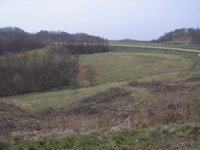The last few months’ blogs have provided a background for the Rappanos case and outfalls, but what does it really mean to the regulated. Now that the COE has prepared its guidance and completed initial field training of its staff, what will this case mean to the regulated community (i.e., developers and contractors)? An active project is presented to generate discussions on the actual implications to developers and what might be done to expedite the process.
A family farm containing rolling meadows, perennial stream, pond, wetlands, and drainage swales or areas was purchased for construction of residential dwellings. The potential impacts to “waters of the state” were greater than 300 feet and an individual permit (IP) through the COE would be required. Here’s the permitting process and schedule:
The reauthorization of Nationwide permit process (no pre-application site visits), regulatory process for approval of state water quality conditions, and the Rappanos decision have resulted in an extended permitting process, loss of summer and fall construction seasons, possible loss of matching federal monies, and additional labor for both regulators and engineering contractors. The current IP process will be a minimum of 8 months even with the consultant’s contacting coordinating agencies directly, providing of plans in anticipation of COE requests, and political pressure. As a colleague said in passing, “ Maybe we could draft the permit for COE to help them out”, how else can the regulated help?
